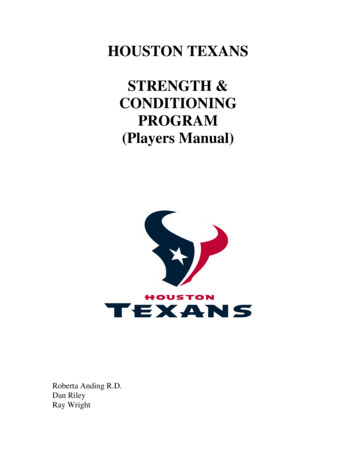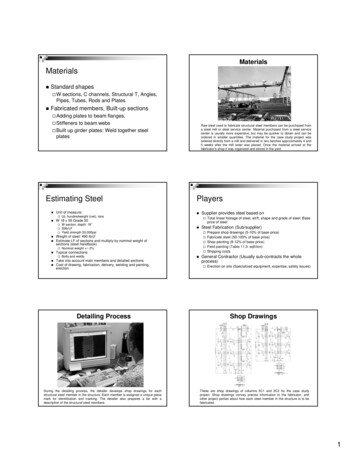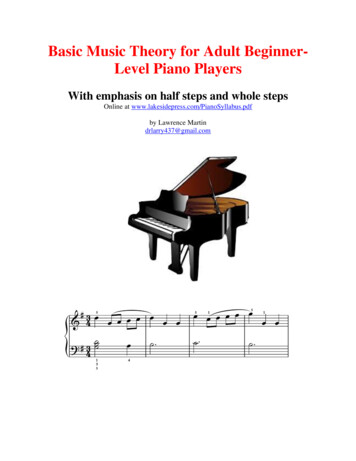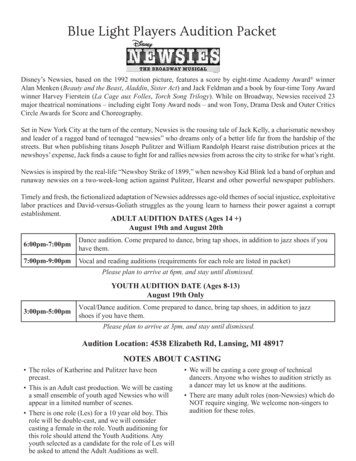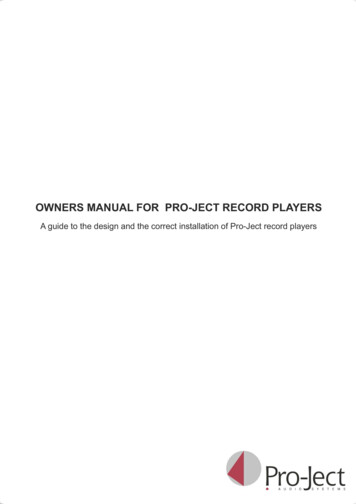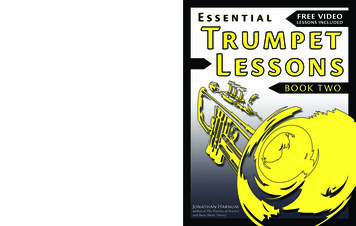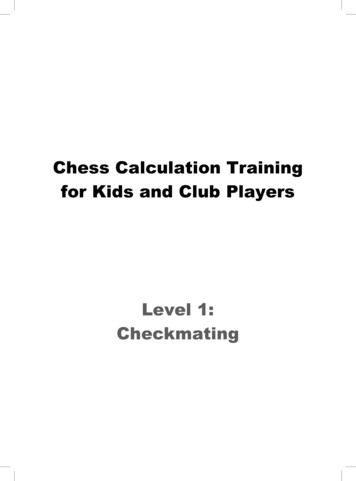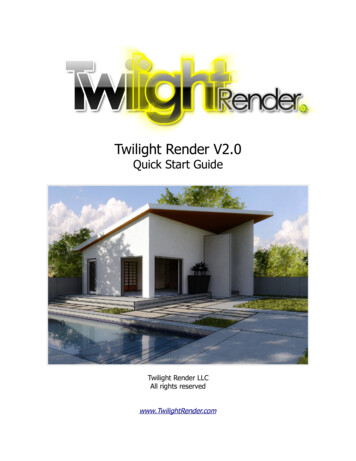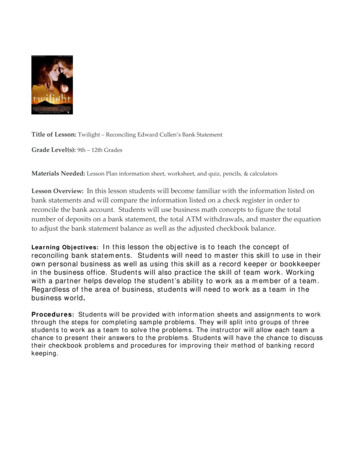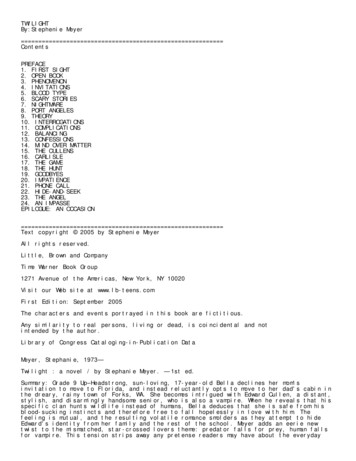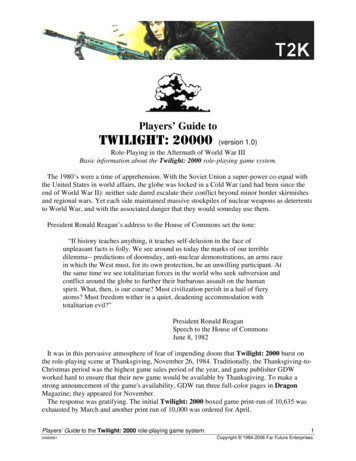
Transcription
Players’ Guide toTWILIGHT: 20000(version 1.0)Role-Playing in the Aftermath of World War IIIBasic information about the Twilight: 2000 role-playing game system.The 1980’s were a time of apprehension. With the Soviet Union a super-power co-equal withthe United States in world affairs, the globe was locked in a Cold War (and had been since theend of World War II): neither side dared escalate their conflict beyond minor border skirmishesand regional wars. Yet each side maintained massive stockpiles of nuclear weapons as deterrentsto World War, and with the associated danger that they would someday use them.President Ronald Reagan’s address to the House of Commons set the tone:“If history teaches anything, it teaches self-delusion in the face ofunpleasant facts is folly. We see around us today the marks of our terribledilemma-- predictions of doomsday, anti-nuclear demonstrations, an arms racein which the West must, for its own protection, be an unwilling participant. Atthe same time we see totalitarian forces in the world who seek subversion andconflict around the globe to further their barbarous assault on the humanspirit. What, then, is our course? Must civilization perish in a hail of fieryatoms? Must freedom wither in a quiet, deadening accommodation withtotalitarian evil?”President Ronald ReaganSpeech to the House of CommonsJune 8, 1982It was in this pervasive atmosphere of fear of impending doom that Twilight: 2000 burst onthe role-playing scene at Thanksgiving, November 26, 1984. Traditionally, the Thanksgiving-toChristmas period was the highest game sales period of the year, and game publisher GDWworked hard to ensure that their new game would be available by Thanksgiving. To make astrong announcement of the game's availability, GDW ran three full-color pages in DragonMagazine; they appeared for November.The response was gratifying. The initial Twilight: 2000 boxed game print-run of 10,635 wasexhausted by March and another print run of 10,000 was ordered for April.Players’ Guide to the Twilight: 2000 role-playing game system.200609011Copyright 1984-2006 Far Future Enterprises.
THE CHALLENGE OF MILITARY ROLE-PLAYINGSerious role-playing games are built around drama, and there is no situation more dramaticthan that of a soldier in wartime, so you might think the military is a natural setting for roleplaying. However, RPGs work best in anarchic situations--- where the player characters are theirown bosses--- and, in the army, discipline and coordinated group action are the keys to success.To get around this, the most successful military RPGs have settings where small groups can actwith a large degree of autonomy, on commando raids, during guerilla warfare, or (most popularof all) after civilization has broken down due to holocaust or invasion.The first attempt at military role-playing was Eric Goldberg's Commando (SPI, 1979), whichwas primarily a board game of small-unit combat that had some role-playing features. The firstversion of The Morrow Project (Timeline, 1980) was also mainly a set of combat rules, but thedesigners were perceptive enough to set it in a post-holocaust future where the players couldhave freedom of action. This was also the case with Aftermath (Fantasy Games Unlimited,1981), a game of paramilitary survival after a nuclear war.These were followed by Behind Enemy Lines (FASA, 1982), a World War II game; Recon(RPG Inc., 1982), set on the fringes of the Vietnam War; and Merc (Fantasy Games Unlimited,1983), which tried to capitalize on the brief public fascination with mercenary soldiers fightingin Third-World nations. None of these games met with sustained success. It looked as theremight not really be a steady market for military RPGs until GDW released Frank Chadwick'sTwilight: 2000 in 1984. Once again the setting was after civilization was shattered by WorldWar III, but this time background was more believable and worked out in great detail. The ruleswere unexciting but solid, and GDW supported them with a steady stream of scenarios andsupplements that catered to players' fascination with modem military machinery. Othercontemporary military systems debuted in 1986 (The Price of Freedom, West End Games;Phoenix Command, Leading Edge Games; Delta Force, Task Force Games; FreedomFighters, Fantasy Games Unlimited), but none have been able to make much headway againstTwilight: 2000, which recently [1988] received a complete updating and revision.Lawrence SchickHeroic Worlds,A History and Guide to Role-Playing Games,Amherst, NY: Prometheus Books 1991Game Designers' Workshop began to make a name for itself in modern military war gameswith the introduction, in 1983, of its Assault tactical war-game series (consisting of Assault,Boots & Saddles, Chieftain, and Reinforcements). Assault dealt with the capabilities of smallunits and individual armored vehicles in the modern (World War III) military environment.Close on its heels (early 1984) came the Third World War strategic war-game series(consisting of Third World War, Arctic Front, Southern Front, and Persian Gulf), laying outall of Europe in consistent scale maps in four different games. Third World War dealt with thestrategic operations of military units in a hypothetical, but genuinely possible, World War III.Players’ Guide to the Twilight: 2000 role-playing game system.200609012Copyright 1984-2006 Far Future Enterprises.
Is it any wonder that board game publisher GDW turned its attention to a military role-playinggame? Initially, Frank Chadwick’s design concepts envisioned extreme environments withfeatures of Mel Gibson's Mad Max and Andre Norton's Star Man's Son. Unfortunately, suchconcepts were already common (and not especially successful) to the market place. Thebreakthrough came on a long drive back from the Origins Game Convention (Dallas, 1983). Inan overloaded rental van, Frank Chadwick, Loren Wiseman, Bill Keith, and Andrew Keith talkedfor hours about a modern military role-playing game which concentrated on equipment andrealistic military situations, and by the end of the trip the concept for Twilight: 2000 was farenough along for specific design to begin in earnest.The Twilight: 2000 role-playing game system is available as Ebooks at DriveThruRPG.com.They have exclusive arrangements with many top RPG publishers (including us!) for Ebookeditions of out-of-print and current role-playing books, adventures, and modules. Ebooks are insecure PDF format (you need Adobe Acrobat 6 with Digital Rights Management activated).The Core Rules for (version 1.0) for Twilight: 2000 are available in a printed, hardcopyformat. The softcover book includes all of the materials from the original boxed edition, plus thefour Poland adventures (The Free City of Krakow, The Pirates of the Vistula, the Ruins ofWarsaw, and the Black Madonna), and the published errata for the core rules. 35.Click Here to s’ Guide to the Twilight: 2000 role-playing game system.200609013Copyright 1984-2006 Far Future Enterprises.
THE TWILIGHT: 2000 CONCEPTFive years ago, the nations of the world began their war for global supremacy.Three years ago, a massive nuclear exchange failed to give any side the decisive advantagethey sought.One year ago, the US Fifth Infantry Division launched a drive into enemy-held Poland, part ofan offensive to knock the Soviets back to their homeland.It failed. Now the Red Diamond is deep in enemy territory, reduced to small units withoutsupport, supply, or reinforcement. The war for Europe has turned into the war for survival.Now what?GDW presents a new concept in role-playing. World War III began fiveyears ago. It’s still going on, but that’s the least of your problems. A few daysago, you were soldiers in the U.S. 5th Division. Now you’re just fighting tosurvive while the world falls apart around you.Welcome to 2000 AD. Your equipment was brand new in 1995; now it’s wearing out. Gasolineis rare, so your vehicles run on alcohol you distill yourself. And 5th Division’s cavalry—whenthere was a 5th Division—rode horses. There’s not much government left in central Europe, justwarlords, marauders, and free cities. Even the major powers are collapsing; some units, evenwhole divisions, are refusing orders and heading home.Your division is gone, and you’re hundreds of kilometers inside enemy territory; fortunately,the Soviets aren’t in much better shape than you are.Your job is to stay alive, find enough fuel and spare parts to keep moving, get home (whereverthat is), and maybe even strike at the enemy.The real trick in designing a role-playing game is to produce detailed, accurate effects withsimple systems. That takes inspiration and a lot of work, and that’s what we did. Twilight:2000’s comprehensive rules cover combat, skills, survival, encounters, and more with easy-touse and flexible but well-defined systems.Players’ Guide to the Twilight: 2000 role-playing game system.200609014Copyright 1984-2006 Far Future Enterprises.
Canon. noun. A body of rules or principles generally accepted as authoritative and fundamental in afield or art or philosophy: for example, "the neoclassical canon"; "canons of polite society."THE TWILIGHT: 2000 CANONThe canon (the “official” texts for the Twilight: 2000 role-playing game) consists of the rules,adventures, and sourcebooks published by Game Designers' Workshop, either directly or throughChallenge Magazine. A few select materials have become apocryphal (that is, contemporaneous,but not quite official): City of Angels (3W), and three Finnish language Twilight: 2000modules, Erikoisjoukot, Pohjoismaat, and Kööpenhaminaan! (FGH).Twilight: 2000 has three authoritative game rules systems. Version 1.0 is the original rules set(1984) associated with stock numbers in the 500 series. Version 2.0 is the revision (circa 1988)associated with stock numbers in the 2000 series. In an effort to enhance compatibility betweengame systems, GDW ultimately produced Version 2.2 (1991) which conformed to the GDW“house” system which made it compatible with the Traveller: The New Era game system.TWILIGHT: 2000 Version 2TWILIGHT: 2000 Version 10500 v1.0 Boxed Set0501 Free City of Krakow0502 Pirates of the Vistula0503 Ruins of Warsaw0504 US Army Vehicle Guide0505 The Black Madonna0506 Going Home0507 Red Star, Lone Star0508 RDF Sourcebook0509 Armies of the Night0510 Allegheny Uprising0511 Airlords of the Ozarks0512 Gateway to the Spanish Main0513 King's Ransom0514 Soviet Vehicle Guide0515 Urban Guerilla0516 Small Arms Guide0517 The Last Submarine0518 Kidnapped0519 Howling Wilderness0520 Mediterranean Cruise0521 Boomer0522 Satellite Down0523 Return to Warsaw0524 Bear's Den0525 Heavy Weapons Guide0526 NATO Vehicle Guide0527 White Eagle0528 Survivors' Guide to the UK0551 Last Battle0552 Twilight 007,27510,20010,5005,1007,1108,0636,0302000 V2.0 Rules (includes 7,757 v2.2)2001 V2.0 Boxed Set2002 Infantry Weapons2003 US Vehicle Guide2004 Soviet Vehicle Guide v22005 Merc: 20002006 Bangkok2007 NATO Vehicle Guide v22008 Merc Gazetteer2009 Nautical and Aviation Handbook2010 Twilight Nightmares2011 Heavy Weapons Handbook2012 Special Operations2014 Castle by the Sea2015 Referee's Screen2016 Operation Crouching Dragon2017 Eastern Europe Sourcebook2018 Rendezvous in Krakow2019 Death on the Vistula (unpublished)2020 Warsaw Phoenix (unpublished)THE APOCRYPHA5401 City of Angels2,0000101 Erikoisjoukot ( Special Units)1,0000102 Pohjoismaat ( Scandinavia)1,0000103 Kööpenhaminaan! ( Copenhagen)1,0000000 Twilight: 2000 (Paragon) (computer)23,730These listings include stock number, title, and totalunits printed (and theoretically sold). Data was takenfrom printing records (GDW-published material) androyalty reports (3W and FGH).Players’ Guide to the Twilight: 2000 role-playing game 04,1004,450005Copyright 1984-2006 Far Future Enterprises.
COMPARING THE MODULESThe published Twilight: 2000 modules were rated in a survey of 42 players and owners who were asked to rateeach module on a scale from 1 to 10 (10 is best). No specific criteria were specified; the assumed criteria being"general satisfaction." The responses were tabulated to create a set of uniform ratings for the modules.Normed Ratings: Some respondents clustered their ratings in the 7-8-9 range; others used the entire range ofvalues from 1 to 10. To account for these differences, each set of responses was "normed." Each respondent’sratings were averaged. Responses above average were re-stated in equal one-fifth increments between average and10, and responses below average were restated in equal one-fifth increments between 1 and average. For example,"John's" ratings averaged 8. That 8 is normed to 5, and all 9's become 7.5 and all 10's become 10. "Bill's" ratingsaveraged 4. That 4 is normed to 5 and all 5's become 5.8, all 6's become 6.6, all 9's become 9.1, and all 10's remain10. Average rated modules are shown here as 5's: their highest rated modules are similarly high, their lowest ratedmodules are similarly low. Zero or no response ratings were ignored.For the entire range of modules shown, a normed 5 is the equivalent of a raw 7.36. If one new rating of 10.0 for amodule were to be received, the ranking would be increased by approximately 0.15. If one new rating of 1.0 were tobe received, the ranking would be decreased by approximately 0.15.Interpreting These Results. Any rating less than 5 is below average. By definition, half of all modules are belowaverage. For example, Rendezvous in Krakow (3.3) received the lowest rating of the group; its raw average ratingwas 4.0. RDF Sourcebook (7.9) received the highest rating of the group; its raw average rating was 9.0.No.05080506051405010500052805192001052
Twilight: 2000, which recently [1988] received a complete updating and . secure PDF format (you need Adobe Acrobat 6 with Digital Rights Management activated). The Core Rules for (version 1.0) for Twilight: 2000 are available in a printed, hardcopy format. The softcover book includes all of the materials from the original boxed edition, plus the four Poland adventures (The Free City of .

